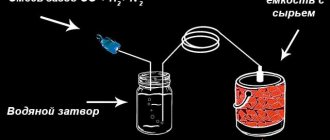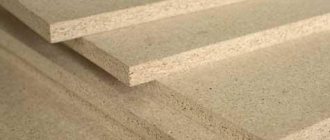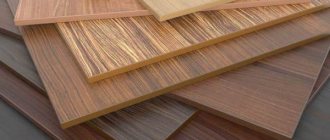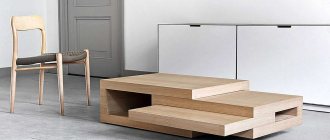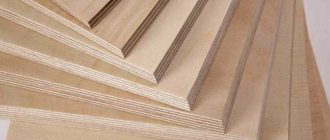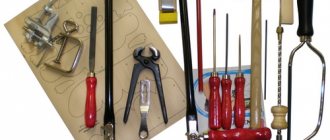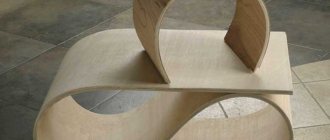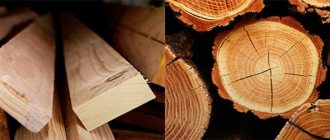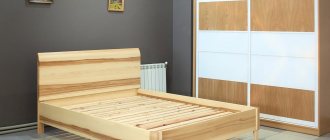The structure of the laminated chipboard board is distinguished by a huge range of shades and patterns, imitating the texture of natural wood, stone, marble chips or abstract patterns. The result of the cladding process is laminated chipboard.
The coating has the same properties as regular plastic: it better withstands water, detergents, damage, and temperature changes. Widely used in furniture production, both cases and facades.
Laminating is a decorative coating made of paper impregnated with paraffin or resin compounds. This film is less resistant to moisture, elevated temperatures, and mechanical damage. It is used in the manufacture of inexpensive furniture and large wall panels.
Veneering – veneering with a thin layer of veneer (cut of valuable wood). Doors and components, furniture facades, and sometimes even wall and ceiling panels are made from this material.
Painting with any types of varnishes and paints. This means of refining the slab is considered the most economical and “homey”.
What's better?
The cost of finished furniture products depends on what material is used for their production.
Therefore, budget-class furniture uses inexpensive chipboard panels, which can be covered on only one side with a moisture-protective film. In addition, for the production of furniture, the factor that matters is whether the material from which it is made emits formaldehyde. For example, for a bed, a higher quality laminated chipboard material will be used, since its protective layer does not allow vapors of a harmful component to escape. The cost of budget furniture made from chipboard is also affected by the type of material. There are several types of particle boards.
- Grade I - sawdust of a small standard fraction without any foreign inclusions is used as a raw material for the manufacture of panels. The finished chipboard is perfectly flat, smooth, and has no chips or cracks. The first grade of chipboard must be additionally decorated with film or veneer, and this is done on both sides of the chipboard.
- Grade II - made from high-quality sawdust raw materials of different fractions, a minimum percentage of foreign impurities is acceptable. The finished slab may have minor damage in the form of chips or scratches. For grade II chipboard, decorative cladding may not be used.
- Grade III - made from sawdust of various wood species, may include a small percentage of foreign inclusions. The material is not subjected to decorative cladding, since this grade is not used in furniture production. Grade III chipboard can be used only for construction purposes.
Based on the type of protective coating, particle boards are divided into the following main types:
- without cladding - such material is called rough; it is used only when performing construction work;
- laminated - chipboard has a durable varnish coating or treatment in the form of a melamine film;
- veneered - chipboard has an external finish with natural wood veneer.
Unlike chipboard, laminated chipboard materials have a wider variety. Lamination of the plate can be done in various color shades, as well as create an imitation of any texture. Furniture products made from laminated chipboard can be harmoniously integrated into almost any interior composition. They look good and elegant, and at the same time have a low, quite affordable cost. In some types of laminated chipboard material, a fire-resistant film containing carbon or HLP class material, which is resistant to fire, can be used as a laminating layer.
Laminated particle boards, despite many of their advantages, are prone to chipping and cracking. Most often this occurs from heavy objects falling onto the surface of the slab or under the influence of a mechanical factor. It is no longer possible to eliminate such a defect in furniture. Due to this property of the material, it is not subjected to various treatments by milling, so it is impossible to obtain a relief surface, smooth bevels or roundings from the laminated chipboard panel.
When a chip or crack appears, the surface of the laminated chipboard loses its safety, as formaldehyde begins to release outward, so the quality of the laminating layer and its stability play a very important role for this type of chipboard.
Chipboard material is not used for the manufacture of countertops or kitchen units, since only the laminated chipboard surface can withstand frequent and prolonged contact with water without compromising its appearance. Although prolonged wetness is undesirable even for laminated boards, such exposure from the edges of the material is especially dangerous.
To produce low-cost, but high-quality and beautiful furniture, modern manufacturers use both woodworking products - chipboard and laminated chipboard, and ordinary chipboard is used to create the load-bearing frame of the furniture, while the facade part is made using laminated board. Furniture products made from a combination of materials can be used both for home use and in office spaces.
See the following video about the differences between materials.
Properties of laminated chipboard
Laminated chipboards (LDSP) are characterized by low cost, resistance to temperature changes and a wide range.
The laminated coating can be made in almost any color and texture, which allows you to choose laminated chipboard furniture for the interior in any style. It belongs to the economy class because it has an affordable price.
Furniture made entirely of laminated chipboard has straight lines and looks more laconic even with a beautiful image on the film.
It should be noted that chipboard is used to make a durable material lined with plastic, which is called postforming. It goes into the production of countertops. However, this is not laminated chipboard in the usual sense.
Among the disadvantages of laminated particle boards are the tendency to chip on the surface and the impossibility of milling. The latter property makes it impossible to obtain smooth angles and bevels, or a relief surface.
LDSP differs from MDF for the worse in that it is less resistant to moisture. Although there are also moisture-resistant types of panels, their price is much higher.
Chipboard and MDF - what's the difference?
Due to the difficult situation of the post-war period, many industries were forced to look for alternative materials for the manufacture of products. Although wood was considered the most expensive option, it was still unaffordable for many buyers. In view of this feature, a new material was introduced, which was lower in cost, but in terms of quality characteristics was practically not inferior to natural wood.
If we bypass all the subtleties of the manufacturing process of this material, we can say that both MDF and chipboard are firmly compressed lumber, which are glued together with special viscous resins. Safety, service life and scope of application of materials directly depend on what resins were used, in what quantity, and what quality.
The composition of particle board (chipboard) includes compressed shavings and sawdust impregnated with formaldehyde resins. Depending on the grade, chipboard has different quality characteristics: from a loose material with a density of 300 kg/m3 to a more durable and expensive one with a density of 600 kg/m3, which is precisely used in the manufacture of furniture.
Modern production makes it possible to minimize the harmful effects of the binder resin and improve the appearance of the slab by coating it with melamine film - lamination. Hence the name “chipboard”. The film has good aesthetic properties and does not allow formaldehyde to evaporate.
MDF immediately has a smooth and even surface. This board is denser and more durable, resistant to drilling and moisture compared to laminated chipboard. It is also better suited for deep milling and deformation when creating radius furniture facades. In addition, MDF board has significantly higher environmental properties due to the fact that mainly natural resins, lignin and paraffin are used as sawdust impregnation. Formaldehyde is also present, but in much smaller quantities.
To make the differences between the two materials more clear, you can compare the structure of chipboard with a heterogeneous raw material passed through a blender, and MDF with a product from a meat grinder. The density of MDF board varies from 600 to 800 kg/m3, which in conditions of high moisture allows the material to surpass even natural wood in some characteristics.
There are several general conditions for caring for furniture made from MDF or laminated chipboard.
- Prolonged exposure to high temperatures is undesirable: at 75 degrees and above, peeling of the coating is possible.
- Another factor is sunlight, which can also change the appearance of the slab. Film on laminated chipboard is more susceptible to fading, although MDF may change color somewhat with constant exposure to sunlight.
- You also need to be careful about long-term interaction with water. If the joints of the coating are not sealed, when water gets inside the slab, the sawdust will swell, and the slab itself will lose its appearance and properties. However, this is an extreme case. Under normal household conditions, with short-term exposure to water, which is inevitable in the kitchen, the stove can retain its original appearance for a long time. MDF manufacturers claim that fiberboard can withstand even a small flood.
The common advantage of both materials compared to natural wood is resistance to pests and fungal infection.
General requirements for care and operation
When choosing a place for furniture made of MDF or laminated chipboard in the kitchen, you must take into account that both materials are resistant to temperatures above 75 ℃. When exposed to high heat, the coating begins to peel off. For this reason, heating devices should not be placed in close proximity to furniture.
If a furniture set is constantly illuminated by the bright sun, then it may simply fade and lose its attractiveness. Chipboard lamination is especially susceptible to fading.
Severe wetting of the slabs is undesirable, although they can withstand short-term exposure to water well, which is why they are used for sinks and other kitchen furniture. Much depends on the quality of the material. There are often cases when laminated chipboard sheets begin to become saturated with water, swell, and crumble. Such furniture takes on a terrible appearance, is destroyed, and becomes completely unusable.
General rules of care are:
- wipe the dust with a dry cloth or a special compound for plastic;
- promptly remove moisture from the surface with an absorbent sponge;
- do not overload hooks and shelves so that fasteners do not break off;
- Do not use waxes and mastics intended for polished wood.
The last point is worth focusing on. Polishing agents intended for wood are not suitable for MDF and laminated chipboard. The laminated film may change color under their influence and even peel off. You should also not use acids, alkalis, or abrasives.
Both types of slabs are resistant to pests and mold. In a dry room, they can stand for decades without any additional treatment without collapsing. They are used to make beds, tables, cabinets, chests of drawers, bookcases, shelves, and all kinds of kitchen cabinets.
Differences between chipboard, chipboard and MDF
In the same IKEA we see furniture made from laminated chipboard and MDF, visually perceiving only the difference in price (with the exception of particularly glossy ones - there the differences are obvious to the eye). Furniture made from MDF is much more expensive. Why? What is the difference between chipboard, laminated chipboard and MDF - one board made of wood particles from another?
Let's start with the fact that the difference between chipboard and chipboard is lamination. Natural veneer is no worse than laminating film, but it is not practical to process chipboard with it, so further we will talk about the difference between laminated chipboard and MDF.
List of differences:
- Laminated chipboard is much less resistant to moisture. It would seem that the water has nowhere to go, but between the edge and the laminating film the liquid finds (as the proverb says) a microscopic gap and penetrates inside. It remains inside (for rapid evaporation, an area is needed, but there is none), expanding the chipboard to unimaginable sizes. However, long before the extra 20-30% in volume is added, the sheet will warp, the film or veneer (whatever it may be) will crack. A few drops of water falling in the wrong place can irreversibly damage the tabletop. Even the so-called waterproof material still absorbs moisture - such is its structure.
- Chipboard is more toxic. It is precisely more toxic, because the information about the complete non-toxicity of fibreboard is incorrect: even if the material emits the same amount of formaldehyde as natural wood, this does not mean that there are no emissions at all. It is there, but much lower. It happens that they write that there is no formaldehyde in MDF - this is not true (moreover, formaldehyde is everywhere: it is used in medicine, the food industry as E240, it is used for fumigation of grain, the substance is part of cosmetics, it is found in the human body - it is a matter of concentration ). Wood fibers are impregnated with urea resins containing formaldehyde. Modification helps reduce emissions.
- MDF is suitable for making furniture of complex shapes, which is not possible from laminated chipboard.
- MDF has a higher density - you can mill it and make inclined holes. The material “holds” fasteners much better.
- There are practically no differences in color solutions, with the exception of glossy MDF (but this is no longer a color) and custom-made ones - the enamel can be tinted in any shade that comes to mind, so here MDF is a winner.
- MDF is noticeably more expensive, which is due to the quality parameters of the material. However, this high cost is apparent, which is clear to any person who knows how to count: even according to rough estimates, furniture made from MDF will end up being cheaper because it will last much longer.
There is no edge - the entire slab is covered with a single layer, which eliminates gaps between the film and the edge
Chipboard or MDF? MDF is inferior to laminated chipboard only in price, but this may not be significant if all the advantages are taken into account. When purchasing furniture, the decision is made by the buyer; we can only advise making an informed choice.
No matter how much you want to save money, it is better to give preference to high-quality material - environmentally friendly, which is actually important, because the temperature in the kitchen is often elevated, and the emission of formaldehyde increases from heat (we do not understand why E2 is prohibited only in the production of children's furniture - in the kitchen this type of product is even more harmful). We repeat, the savings when choosing furniture made from chipboard are illusory
Again, aesthetic properties matter.
Chipboard
In the production of chipboards, wood shavings of low-value deciduous and coniferous wood are used, adding formaldehyde resin. And it is precisely this material that usually raises not the most flattering questions from the buyer.
However, when purchasing an E1 stove, you can put aside doubts about the harmful effects of this material on the body. In addition, conscientious manufacturers cover the surfaces of furniture parts with film or veneer, and seal the ends with edge material. In this way, completely “preserving” the chipboard underneath.
The industry does not stand still, and the initially unattractive slab material has become accustomed to being covered with a polymer film (chipboard) or HPL plastic (4-6 mm thick), resulting in an effective and highly durable material.
Nowadays fashionable products with HPL coating are durable, resistant to damage and moisture, high density and easy to maintain, which is especially important in the production of kitchen sets. It won’t be difficult to clean up pomegranate juice or red wine spilled on such a countertop! There will be no trace left on the product, as well as on your nervous system.
Furniture boards for a children's room: pros and cons
We always approach the arrangement of a children's room with special care and think through every little detail. The range of children's furniture is large. Some parents buy ready-made furniture, others make it themselves, according to their own plan and design, taking into account the characteristics of the children's room; the rest buy furniture panels and assemble them themselves.
Children's furniture is made from different materials: natural, MDF boards, chipboards, laminated chipboards, fiberboard, plastic, etc. Of course, it’s nice if the furniture is made of natural wood. However, many families with children do not have the opportunity to purchase or custom-make such furniture. Then an alternative to natural wood comes to the rescue - MDF, chipboard, etc.
Let's consider MDF materials for making children's furniture in the room.
MDF is a medium density board with a wood fiber structure. Small sawdust is used to make it. Such sawdust is held together by lignin and paraffin. These boards are safe for the health of people, especially children, which is why their price is higher than that of chipboard boards. Thus, MDF boards for children's furniture are environmentally friendly and soft material. Such slabs are used to make the backs of cribs, tables, high chairs and chairs for children over 3 years old, cabinets, shelves and various parts.
The back walls of the cabinet and the bottoms of the drawers are made from chipboard boards. A wardrobe is essential in a children's room, so it is better if it is made to order from reliable materials. The fact is that the bottom of chipboard boards is very flexible, it bends under the heavy weight of children's things, so this furniture has to be repaired very often. Agree, the main argument of low price and durability is not easy to dismiss, but furniture made from chipboards also has a significant disadvantage: the presence of formaldehyde resins in the material. It is resins that impregnate and bind sawdust and shavings. Resins make chipboard boards resistant to moisture.
For the production of children's furniture from chipboards, the emission level of formaldehyde resins is taken into account. The level of E1 resins in the boards is relatively safe, therefore it is allowed to make both children's furniture and components from them.
Furnishing a child's room is not easy and often very expensive. For a children's corner, MDF boards would be most preferable. They contain phenol and formaldehyde resins, however, their amount is small, that is, within normal limits. Therefore, in percentage terms (50-60%) MDF boards are equal to pure materials in terms of environmental indicators. Children's furniture made from MDF boards does not have a toxic coating and does not harm the fragile children's body.
When choosing between materials for making children's furniture, you can choose to combine them. Some manufacturers make furniture with a combination of natural wood and MDF boards. Such furniture is cheaper than analogues made from natural materials.
Thus, the use of MDF and chipboard furniture in a children's room is possible if they have the appropriate quality certificate.
There are not many advantages to furniture boards using resins. If MDF boards still inspire confidence among buyers of joinery products, then chipboard boards do not lend themselves to any criticism. First of all, chipboards are the final product of processing natural wood (sawdust, shavings). Such products cannot be 100% safe.
Furniture boards made from natural wood have a lot of advantages. They have one significant disadvantage - high cost. It is worth considering that you need to buy furniture boards made of natural wood with a quality certificate. If the processing technology of natural wood (alder, pine) is not followed, the quality of such boards leaves much to be desired, despite their natural origin. The most acceptable option is to make furniture boards yourself from wood (pine, beech, alder, birch, oak).
We rely only on ourselves: 7 simple ways to check furniture for quality (15 photos)
It would seem that it could be easier than coming to the store, choosing the model you like, paying and immediately starting to actively use it. But in this case, the question arises: how long will you enjoy your purchase. We often don’t think about this, and all furniture for us most often differs only in design.
Buying a pig in a poke is not pleasant, so it is important to first make sure that you are looking at a truly high-quality product.
Remember: The miser pays twice.
So, in order for the purchased kitchen, wardrobe, bed and other furniture to please you for many months, and so that you do not feel ashamed in front of your guests and your wallet for wasting money, be sure to remember the following rules. These are the ones you need to pay attention to when buying furniture. 1. We evaluate laminated chipboard (laminated chipboard)
One of the most important indicators that you have a high-quality laminated chipboard is the absence of odor. We all care primarily about our own health and, especially, the health of our children, so be sure to ask the seller for a certificate for this material. This is where the level of formaldehyde (POISON) content is indicated. The E1 formaldehyde content indicator means that the material is safe for health. Only this material is allowed for the manufacture of children's furniture. Laminated chipboard with an E2 index and higher is not recommended for the production of any furniture. The presence of a pungent odor in furniture indicates a high content of formaldehyde (POISON). Exceeding it leads to a deterioration in general health - headaches, allergies, coughs, asthma attacks, etc. With all this, children are more sensitive to the environment, and therefore the effect of formaldehyde on the child’s body is much more serious.
MDF and laminated chipboard: what is the difference
The composition of particle board (chipboard) includes compressed shavings and sawdust impregnated with formaldehyde resins. Depending on the grade, chipboard has different quality characteristics: from a loose material with a density of 300 kg/m3 to a more durable and expensive one with a density of 600 kg/m3, which is precisely used in the manufacture of furniture.
Modern production makes it possible to minimize the harmful effects of the binder resin and improve the appearance of the slab by coating it with melamine film - lamination. Hence the name “chipboard”. The film has good aesthetic properties and does not allow formaldehyde to evaporate.
The production of MDF boards takes place using improved chipboard production technology - by drying wood fiber and hot pressing. Medium Density Fiberboard (MDF) contains only the finest sawdust, compressed to a homogeneous state. Unlike chipboard, which must be thoroughly sanded before covering with film,
MDF immediately has a smooth and even surface. This board is denser and more durable, resistant to drilling and moisture compared to laminated chipboard. It is also better suited for deep milling and deformation when creating radius furniture facades. In addition, MDF board has significantly higher environmental properties due to the fact that mainly natural resins, lignin and paraffin are used as sawdust impregnation. Formaldehyde is also present, but in much smaller quantities.
To make the differences between the two materials more clear, you can compare the structure of chipboard with a heterogeneous raw material passed through a blender, and MDF with a product from a meat grinder. The density of MDF board varies from 600 to 800 kg/m3, which in conditions of high moisture allows the material to surpass even natural wood in some characteristics.
Caring for laminated chipboard or MDF furniture
There are several general conditions for caring for furniture made from MDF or laminated chipboard.
- Prolonged exposure to high temperatures is undesirable: at 75 degrees and above, peeling of the coating is possible.
- Another factor is sunlight, which can also change the appearance of the slab. Film on laminated chipboard is more susceptible to fading, although MDF may change color somewhat with constant exposure to sunlight.
- You also need to be careful about long-term interaction with water. If the joints of the coating are not sealed, when water gets inside the slab, the sawdust will swell, and the slab itself will lose its appearance and properties. However, this is an extreme case. Under normal household conditions, with short-term exposure to water, which is inevitable in the kitchen, the stove can retain its original appearance for a long time. MDF manufacturers claim that fiberboard can withstand even a small flood.
Chipboard or MDF: which is better?
The common advantage of both materials compared to natural wood is resistance to pests and fungal infection.
Advantages and disadvantages of MDF:
Chipboard and MDF: combining materials
The best option for your wallet, without sacrificing quality and durability, is to choose furniture with a combination of materials.
Laminated chipboard will perfectly fulfill its functions as the basis for the kitchen body, and MDF, thanks to the variety of films for coating and the possibility of decoration, will allow you to make beautiful facades that will fit perfectly into the interior of the kitchen. So you shouldn’t choose what’s better for the kitchen: MDF or chipboard? The answer lies in the correct combination of both materials and their rational purpose.
For example, laminated chipboard, in addition to being used in furniture, can be used as an inexpensive, but durable and reliable tabletop of various thicknesses: from 25 to 38 mm. The plate is covered with multilayer plastic using Postforming technology. This slab is resistant to moisture and mechanical damage, so it will last for many years without requiring special care.
High-quality laminated chipboard in combination with MDF can also be used in the production of other furniture, including wardrobes, beds, and furniture groups for a children's room. If the joints and connections of laminated chipboard are reliably protected, and the manufacturer has appropriate certificates confirming the environmental friendliness of the material, then such furniture is safe to use and can deservedly take its place in the apartment.
Which is better: chipboard or MDF
There is no clear answer to this question, because... materials differ in several basic parameters. Let's look at some of them.
Furniture made from chipboard is much cheaper than furniture made from competitive raw materials. This is due to several factors. Firstly, chipboard is a more common option, which means its production has long been put on stream in many factories. Secondly, processing of raw materials is less expensive, because does not require special preparation. The finely dispersed fraction of wood requires a more careful approach. This includes special equipment that dries fibers and pressing machines that require a large area of production premises.
Nowadays, cabinet furniture is rarely made only from MDF, because the final product will cost a fabulous amount. Most often it is used for facades, where more elegant carving is required. And the side walls are often made of laminated chipboard, and the rear walls are made of plywood.
Appearance
The structure of MDF is more flexible in terms of finishing, which means it can be given any shape. That is, carved headboards or cabinet fronts will look more like natural wood. Moreover, there are products that at first glance cannot be distinguished from wood. Of course, it will cost more (see point 1), but it looks more respectable than furniture made from chipboard.
However, furniture made from laminated boards is more variable in terms of color, because the film covering it can not only have any color, but also imitate the color of natural wood. Of course, it is more difficult to give it texture, so the coating simply copies the shade very accurately.
Safety
MDF is a more modern material, which means its production technology has been worked out to the smallest detail. Manufacturers, competing with each other, are trying to use innovative technologies that every year make products safer for use in residential and children's premises.
However, laminated chipboard manufacturers are not lagging behind and are also using new developments that make their products quite competitive. Every year the amount of resins and formaldehydes in the composition decreases, which means the safety of such slabs increases. At a higher cost, it is still worth giving preference to E1 class chipboard, especially if you plan to install this furniture at home and not in a public place.
Wear resistance
The durability of a material depends not only on its composition, but also on operating conditions. For example, in the kitchen and bathroom, any furniture can become deformed under the influence of moisture and temperature changes. The service life is also affected by the microclimate in the room, which, in turn, may differ in winter and summer.
Processing technology and edge material are of no small importance. Modern factories use such types of processing as postforming and softforming
There are no fundamental differences between them, the first one is simply used for products of simple shape. The laminating film is wrapped around the product and completely sealed to the edge.
The softforming method also involves special processing of the edges; its cut is rounded to the front side, which makes the corners of the furniture safer for small children. Both of these methods prevent moisture from entering the edges and inside the slab, which means it will not swell or deform. Both of these methods are great for kitchen and bathroom cabinetry.
Materials that can be used to process the edges of products not intended for wet areas can be:
They do not protect against water ingress very well, but they affect the final cost of the product. Unlike the first two methods, these options are less expensive, but can add zest to the appearance of the furniture. Contrasting or metallic finishes look interesting and extraordinary.
As for the wear resistance of MDF and laminated chipboard, the first option is considered more durable. But due to its high cost, it makes sense to use it only on furniture facades, and make the rest of the array from chipboard. Moreover, the wardrobe in the bedroom is unlikely to be subject to frequent moisture.
To summarize our article, we can say: before giving preference to one material or another, you need to decide under what conditions the furniture will be used. It is better to choose kitchen units with facades made of MDF with edge processing using the softforming or postforming method. And for a simple chest of drawers or cabinet, a more budget-friendly chipboard with acrylic or aluminum edge is quite suitable.
MDF kitchens
The ability to bend the panel transforms utilitarian standard kitchens into spaces that are not devoid of personality and are more suitable for their owners
This is especially important when the kitchen is small: there is no opportunity to play with the arrangement of furniture or the introduction of original details - only the form remains, and MDF ensures its variability
These curved facades are not the work of software at all. The doors are made of perforated MDF - a kitchen that is ordinary in all respects with a standard arrangement of furniture looks extraordinary thanks to the rounded cabinets. And this is the simplest option of all possible.
What in this kitchen in the photo is made of wood? It's likely nothing. Even a log may turn out to be plastic (or polystone, which perfectly imitates any natural materials). The floor, ceiling and furniture fronts (we remind you: the material can be milled) are made of MDF.
Here's some great country music. Either natural wood or MDF can hold glass (especially stained glass) - laminated chipboard will crumble a little faster than instantly. When working with MDF, the master is spared from endless trials in search of the only desired shade (the paintwork, when placed on natural wood, changes color in accordance with the tone and texture of the base), and the customer is spared from exorbitant expenses.
You can make almost any kitchen out of MDF (almost - because there is also stainless steel) - realize a bold idea, create something truly original and enjoy the result every day. Only an array can be better (and even then not always). In our opinion, only an acute lack of funds and an equally urgent need for furniture can drive us into the framework of chipboard. But this solution will be temporary (the furniture will quickly peel off). Make the right choices.
What to choose for each room?
The advantages of MDF are obvious, but it is an expensive material. Furniture made entirely from MDF is rare. Manufacturers usually offer combined options. The cases in the vast majority of products on the market are made from laminated chipboard, and the facades are made from MDF, laminated chipboard or a combination of both. This approach allows you to use all the aesthetic advantages of MDF and prevent a significant increase in the cost of products.
For a layman, the difference between materials in finished furniture is not always obvious. This can often be determined by its appearance - parts with milling and bends are made only from MDF.
For each room in the house, optimal recommended solutions can be identified for the selection of materials in accordance with operating conditions.
- Living room, hallway. For cabinets, cabinets and other furniture in general rooms, you can choose facades from any material in accordance with your budget and individual appearance requirements. In order to save the family budget, laminated chipboard is also quite suitable.
- Kitchen. Here the furniture is subjected to special loads, changes in temperature and humidity, and exposure to food contaminants. If finances allow, purchase a set with MDF facades.
- Bathroom. Here it is definitely recommended to install furniture entirely (including the body) made of MDF. The low moisture resistance of chipboard automatically excludes the use of this material in rooms with high humidity.
- Bedroom. It is better to prefer sets made of MDF. Furniture made from laminated chipboard is acceptable only if it is of very high quality, with careful processing of edges and joints.
- Children's room. In terms of environmental indicators, MDF is undoubtedly better than laminated chipboard.
When choosing materials for furniture, it is necessary to proceed from the operating conditions of the products and financial capabilities. Cost is the only point in favor of chipboard. All other things being equal, MDF is the preferred material for the manufacture of furniture facades. Such products have all the advantages of natural wood, and in terms of strength and moisture resistance they even surpass natural wood, while being much cheaper. A wide selection of finishing materials allows us to produce furniture to suit the individual requirements of each customer.
External differences in materials
Many people are interested in how MDF differs from laminated chipboard in appearance, and how to identify them? The difference is clearly visible in the cut. In MDF it is dense, fine-grained, in chipboard or laminated chipboard it is more heterogeneous, rough, and shavings are visible. On the surface of chipboard without lamination, fibers and shavings are clearly visible, while MDF is more uniform.
If you take MDF and laminated chipboard boards of the same size (in area and thickness), then the weight of the particle board will be less than that of fine particle board.
If there is a milled, carved surface on the material, we can definitely say that it is not laminated chipboard, since nothing can be cut on it. You can’t make small parts from it either, since the material will crumble.
Comparative assessment and application
It is impossible to unequivocally answer the question “which is better than MDF or laminated chipboard.” Each of these plates has its own purpose and, accordingly, scope of use. Panels made from laminated chipboard of class E1 and MDF boards are now widely used in the production of furniture. However, each of these construction and finishing products has its own advantages and disadvantages, which to a certain extent limits and narrows the scope of their application.
Today, in the production of furniture for the mass user, the following practice is widespread:
- facades are made of “Medium Density Fiberboard” panels;
- body elements - walls, bottom, top panel and shelves are made from laminated or multi-layer painted chipboard.
wall made of chipboard; facades made of chipboard
The advantages of “MDF” panels in comparison with other types of material include:
- greater moisture resistance, which makes it possible to use it in the manufacture of bathroom furniture;
- higher strength characteristics, which guarantees more reliable retention of furniture fittings;
- the ability to process (sawing, grinding, milling) edges and surfaces without chipping or delamination;
- possibility of use as a basis for the production of curved products;
- more types of decorative finishes and higher quality lamination.
Various types of laminated particle board, due to their lower unit cost, are more widely used for decorative cladding of interior surfaces of residential premises.
processed mdf sheets built-in mdf cabinet
Today, the following types of particle boards are used for finishing rooms and arranging partitions:
- rough panels, without decorative cladding;
- laminated boards lined with sulfite paper coating;
- veneered materials, where natural veneer of various, often valuable, wood species is used as cladding.
“LDSP” is divided into:
- moisture-resistant, having a special paraffin impregnation, which complements the increased resistance to moisture guaranteed by the manufacturing technology;
- fire-resistant, impregnated with fire retardant additives to prevent fire.
Choice for furniture
Both materials are suitable for its production, but the location and environment in which they will be used must be taken into account. A significant advantage of MDF when choosing between it and chipboard is its environmental friendliness. And although, in the event of a possible fire, its fibrous component ignites faster, thanks to its natural components it does not emit harmful toxic substances. From an economic point of view, chipboard is much cheaper than its counterpart, therefore the furniture costs much less. It is important to know whether MDF panels have the same dimensions or can be selected according to size.
But it should be taken into account that cracks may appear in the places where parts are attached to the chipboard, and if you pull the handles carelessly from their places, then along with them you can tear out a piece of material and get a hole in its place. Therefore, such furniture is short-lived, despite the hardness of the material. Crushing its parts can create additional household problems, especially if crumbs from the attachment points fall off in cabinets where food products are stored.
Information about moisture-resistant MDF wall panels can be found here.
And MDF is not only soft and tough, but also flexible, so there are no problems with fasteners and handles. The material is flexible enough not to break under heavy loads, even torsion. But it has a high cost compared to chipboard.
The video explains which is better than MDF or chipboard for furniture:
The best option when assembling cabinet furniture, chipboard or MDF, would be to combine these materials, then the overall appearance will be beautiful, and the final cost will be much cheaper. If you plan to order or assemble the cabinet yourself, then you should consider the option of making all the moving parts in the form of doors and shelves from MDF, and the structural frame from chipboard. This combination will extend the life of the product, and it will become repairable.
You can read about MDF wall panels for interior decoration, as well as view all the photographs about this material here from the article.
Conclusion
Strength
In terms of the upper limit of this parameter, when it comes to loaded structures, there is no significant difference between chipboard and MDF. However, for other purposes (less critical elements), the choice of chipboard is much wider, since the numerical expressions of this characteristic lie in a fairly large range (density value from 350 to 820 kg/m³). And since this directly affects the cost of products, competent calculation and selection of a sample of the required group allows us to talk about the possibility of optimizing costs.
Degree of edge processing
On the one hand, the finer the fractions, the smoother the surface. If we look at it from this point of view, then MDF is better. Although there are modifications of chipboard that are distinguished by their magnificent appearance. They have a designation in the abbreviation (through a dash) from the letters P-A. These slabs are sanded, so they do not need to be further processed before applying varnish or gluing.
Strength and Density
This parameter is directly affected by the raw materials used in production. Since chipboard is made from solid chips, which can be arranged in any order, its average density will be different, and in a fairly large range - from 350 to 650 kg/m³. At the same time, there are several varieties of chipboards, which differ from each other in compaction density and the ratio of raw materials to the amount of binders.
During the production of MDF, the raw materials are crushed to an almost homogeneous state, so there are no such large differences in density - the average is in the range of 720-870 kg/m³.
As a result, MDF is significantly stronger in strength than chipboards, and in some cases, even certain types of solid natural wood.

